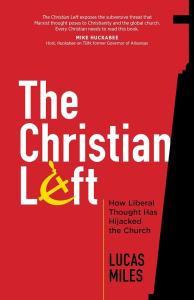by Janine Giordano Drake
Lucas Miles, author of The Christian Left: How Liberal Thought Has Highjacked the Church, thinks that left-leaning Christians don’t take sin seriously enough. He thinks that in our willingness to conform to the faddish principles of “justice” and “inclusivity” in the world, we have turned our back on the “core principles of the gospel”—the good news of personal responsibility, repentance, forgiveness, and personal salvation. While Miles makes an attempt to explain the longer history that has culminated in the current “threat,” I’m going to offer a brief reflection that puts Miles’ concerns in historical perspective.
- Miles is following the Fundamentalist playbook of the 1920s.
Miles does not call himself a fundamentalist, but his insistence that following Christ requires regular Scripture study and a personal acceptance of a relationship with Christ fits him into this theological tradition. He does not call the “Christian Left” modernists, but he characterizes this threat on the church just as fundamentalists of the 1920s might have done.
Early twentieth century fundamentalists called their opponents “modernists” for their willingness to pander to popular discontent with institutional Christianity and question what their grandfathers thought they knew about Scripture and tradition. Modernists were offensive to fundamentalists because they were willing to entertain questions about when various parts of the Torah were really written, whether the book of Job was really a true story, whether Paul really authored all those letters, what to make of the Song of Songs, and what it meant that Jesus was actually a practicing Jew. “Modernists” embraced the “scientific study” of Scripture and understood it as their Christian responsibility to reconcile reason with faith. If we swap in “Marxist Critical Theory” for “Higher Criticism,” or “Evolution,” many of Miles’ passages might have been written in 1923.
- Miles thinks that the concept of “structural sin” is a new, woke idea. He’s mistaken.
Much of Miles’ book is a political manfiesto about how these new, “woke” Christians have “invaded” or “highjacked” the church since the 2010s with a language of “inclusion” and “diversity” and “social justice.” He says that “seeker-sensitivity” has watered down the Christian faith, a tradition that was both more popular and more theologically robust in the early 2000s.
However, seeker-sensitivity is not a new idea. Seeing “social sin” or “structural sin” is also far from a new idea.
In the mid nineteenth century, great writers around the world, including Victor Hugo, Fyodor Dostoevsky, Charles Dickens, and Anna Sewell wrote deeply Christian literature about people (and animals) who hurt others because they suffer from conditions of poverty, neglect and abuse. These authors suggested that we need to see sin as a condition of society, a set of structures that people participate in sometimes unwillingly, and not just a set of trespasses that individuals make with full knowledge of their consequences. When men steal or women participate in the sex industry, when children join gangs or horses throw their riders into the ditch, poor creatures are simply doing what they can to survive within a world that never quite gave them a chance to make sound decisions.
These stories, which filled the minds of late nineteenth century Americans and Europeans, evoked a concept of sin and radical mercy that was structural and not personal. As Anna Sewell wrote in the pages of Black Beauty, “there is no religion without love, and people may talk as much as they like about their religion, but if it is does not teach them to be good and kind to man and beast it is all a sham—all a sham,…and it won’t stand when things come to be turned inside out.”
In the United States and Europe, working-class people, most of whom were not invited to church because they could not afford pew rents, read these books with great interest. Christianity infused the several American social movements of the late nineteenth century, including the Knights of Labor, the Farmers’ Alliance, the trade union movement, and the socialist movement. At the time, most Protestant institutional churches (domains of the aspirant middle classes) were still preaching the “old time religion” of personal faith and personal salvation, but these churches were becoming less and less popular—you might say “relevant”—among the masses.
In the first decade of the twentieth century, a new generation of ministers within the major denominations tried to connect with the poor by giving language to the concepts of “social sin” or “structural sin” within official theological publications. The Baptist minister Walter Rauschenbusch usually gets credit for popularizing the term “social sin” within his 1907 Christianity and the Social Crisis and his 1915 Christianizing the Social Order. It’s important to note that Rauschenbusch was a Baptist who had spent time with the Socialist Party of America and the many heterodox Christians who spent time in these circles. However, Rauschenbusch was not interested in aligning with heterodox Christian theologies. He was interested in giving his blessing to the men and women who burned with passion for social movements and knew this work as part and parcel of their Christian calling. As he offered in the concluding pages to his 1915 book, “Those who have suffered through some social sin can give a meaning and value to their suffering by making it serve the redemption of the race from that sin.” Was Walter Rauschenbusch woke? He was an early twentieth century Baptist who served faithfully in a poor urban neighborhood; his belief in social salvation did not water down his simultaneous belief in personal atonement.
- Miles thinks we can separate social movements from acts of Christian mercy. This is a relatively new idea.
Call me a product of the nineteenth century, but I don’t understand the point of Jesus’ atoning sacrifice if it does not involve the dual process of both forgiving an individual and inviting that person to extend radical grace and mercy within the social relationships of their everyday life. Just as the priest in Les Miserables (1862) says to the lawbreaker Jean Valjean as he absolves him of his sin, “My brother you no longer belong to evil, but to good,” and in the musical, “I have bought your soul for God,” Victor Hugo is arguing that God’s grace sets believers free both to forgive others and to want the very best for them in this world. The proper response to grace is to extend that grace to other people and fight for them, too, to live in a world where they can flourish.
Miles, on the other hand, rooting himself in the modern traditions of Christian conservatism, offers that the church is suffering from the temptation to “find salvation through the unification of the world rather than unity with Christ” (91). Why does Miles insist on a distinction between redeeming the power of sin and death in this world and the next? Why does he believe that the “core principles” of the gospel are apolitical? He stands on an ecclesiastical tradition that has opposed social movements for a while. However, that ecclesiastical tradition has continually lived in tension with movements of lay Christians who have preached the gospel outside of official church sanction.
In the early twentieth century, Christians—both Catholic and Protestant—infused the narratives of social sin, grace, and redemption into popular novels, muckraking journalism and political speeches. In 1907, one minister worried that this doctrine of Christian redemption preached outside the churches was soon going to displace the need for churches. He reflected, “The present writer has heard a dozen impassioned socialists, addressing audiences aggregating ten thousand people, make a finer, a more effective, a more dramatic, a more moral use of the figures, the illustrations, and the moral teachings of the gospels, in a single evening, than he has heard from any dozen preachers in a month in the last twenty years.”
Every one of the social movements of the early twentieth century—the labor movement, the socialist movement, the women’s movement, the temperance movement, the Black Freedom Movement, the movement for indigenous land and rights, the movement for people with disabilities, the movement for the protection of children and animals, the movement for universal education—every one of these movements and more included a number of prominent Christian spokespeople who connected their vision for social change with their commitment to redeeming structural sin. All the best parts of the country we live in were built by people intent on redeeming structural sin.
For the last century, prominent church leaders have been chasing the energy and vision of Christian activists with a combination of fear and jealousy. I’m not sure the present day is much different.














